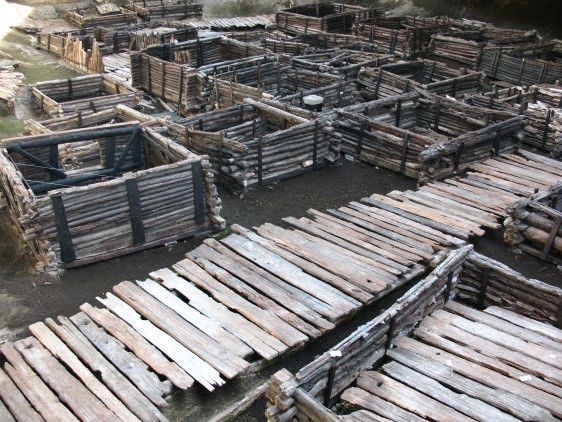Раскоп
Раскоп

Галоўным экспанатам музея з'яўляецца археалагічны раскоп плошчай 1118 квадратных метраў, у якім на глыбіні 4-х метраў знаходзіцца 28 жылых і гаспадарчых пабудоў, датаваных ХІІІ ст., і 2 вулічныя маставыя. Гэта арыгінальная забудова часткі дзядзінца Бярэсця знаходзіцца на яго спрадвечным месцы.
Забудова старажытнага Бярэсця адрознівалася высокай шчыльнасцю – драўляныя пабудовы размешчаныя вельмі блізка адна да адной, часам на адлегласці ўсяго 30 см. Відавочна, гэта тлумачыцца тым, што многія берасцяне хацелі пасяліцца ва ўмацаванай частцы горада, за крапасной сцяной, імкнучыся абараніцца ад нападаў суседзяў.
Для ўзвядзення берасцейскіх пабудоў ужываліся хвойныя пароды дрэва: часцей за ўсё сасна, радзей – ёлка.
Усяго ў ходзе археалагічных даследаванняў было раскрыта 224 пабудовы, якія адносяцца да 13 будаўнічых ярусаў, што паслядоўна змянялі адзін аднаго.
Падлогі ў будынках рабілі з колатых дошак. Дзвярныя праёмы ў хатах былі каля 1 м вышынёй. Вокны прасякалі на шырыню аднаго бервяна або ў двух суседніх бярвёнах амаль пад самым дахам. Дахі былі дашчатыя. Печы рабілі пераважна з гліны, радзей – з выкарыстаннем цэглы і каменю.
Захаванасць драўляных будынкаў Бярэсця ўнікальная. Гэтаму спрыяла вільготная глеба, вялікая колькасць арганічных адкідаў, што рабіла немагчымым пранікненне ўглыб зямлі паветра. У Бярэсці археолагі выявілі дзве пабудовы ХІІІ ст. захаванасцю на 12 вянцоў, што з'яўляецца вялікай рэдкасцю ў славянскай археалогіі. Такая захаванасць пабудоў дала магчымасць прасачыць канструкцыю сярэднявечнага ўсходнеславянскага драўлянага дома.
Вулічныя маставыя вызначалі планіроўку горада і рэгулявалі яго забудову. Драўляныя маставыя ідуць з паўночнага ўсходу на паўднёвы захад (злева направа). Складаліся вулічныя маставыя з лагаў – падоўжных бярвёнаў, выкладзеных на апоры, і папярочнага насцілу з колатых дошак. Па меры таго, як насціл старэў, ён рамантаваўся або замяняўся новым, які ўкладваўся зверху ранейшага.
Горад распасціраецца ва ўсе бакі, пра што сведчаць вуглы нераскрытых пабудоў з усіх бакоў раскопу.
У горадзе з насельніцтвам каля 1,5-2 тыс. чалавек жылі прадстаўнікі ваенна-служылай землеўладальніцкай арыстакратыі, духавенства, гандляры. Асноўную масу насельніцтва Бярэсця складалі рамеснікі. Раскрытая частка дзядзінца – гэта безумоўна рамесны квартал.
Больш за 43 тыс. археалагічных знаходак, зробленых археолагамі пад кіраўніцтвам Пятра Фёдаравіча Лысенкі ў ходзе даследавання гарадзішча Бярэсця, розныя і цалкам унікальныя. Больш за 1000 з іх прадстаўлены ў залах музея для агляду.